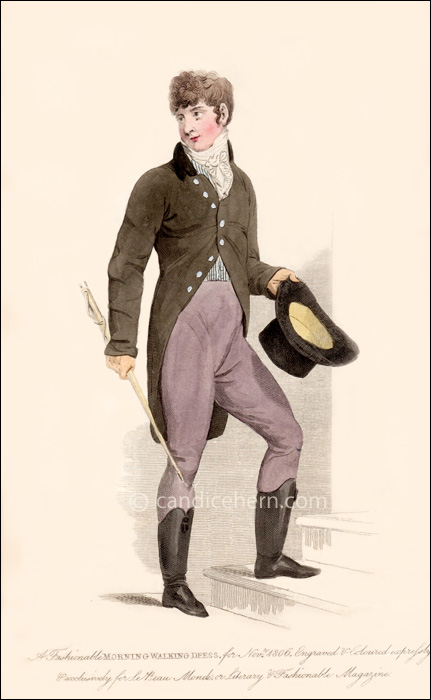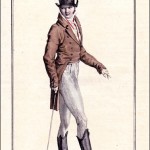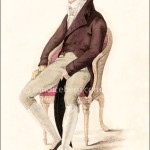Le Beau Monde, November 1806.
“Fashionable Morning Walking Dress”
This short-lived magazine attempted to appeal to the fashionable gentleman as well as the lady, regularly including fashion prints of men’s wear, as well as articles on sporting events, carriages, etc.
The print is described in the magazine as follows:
“MORNING DRESS is a plain single-breasted frock of brown or olive with metal buttons; the waistcoat, of striped toilinette, any colour, is rather longer than formerly; pantaloons, drabs of all degrees, in general worn with Hussar boots; the hat is somewhat broader in the brim, and the hair, though less affecting the antique, is still much dressed as before.”
Both prints and all the fashion commentary from this month’s issue of Le Beau Monde is about men’s fashion. Here are the General observations for the Present Month:
“The neckcloth should, by no means, be too greatly puffed out; but should be neatly united in front with a large unspread bow. Dark bottle green coats will be as generally worn this season, as those of brown colours were last winter.
“For morning dress frock coats will be prevalent: those of an olive hue, with a black velvet collar, will be the most universal. Fancied waistcoats of all manufactures may be worn with this kind of coat; but fashion ordains the invariable use of dark blue or light-coloured kerseymere pantaloons, and half-boots. The boots must rise somewhat higher in the leg than has recently been the custom, and the toes of them should be formed into a perfect semi-cirlce.
“Full dress coats will likewise be made of dark green cloth, double-breasted, and will possess the similar ornament of a black velvet collar. Single-breasted white waistcoats, and light-coloured kerseymere breeches will be in much estimation. Either flesh-coloured or now-white silk stockings fashion now considered as elegant.
“The hair, for morning dress, should be cut à la Titus; for full dress, it should be powdered. Buckles for the shoes are employed in full dress; but ribbands are allowed in afternoon or dinner dress.”








